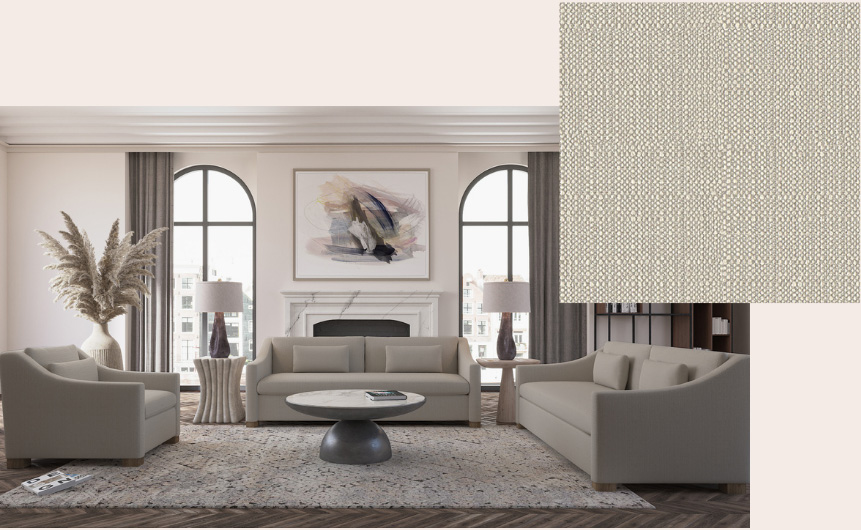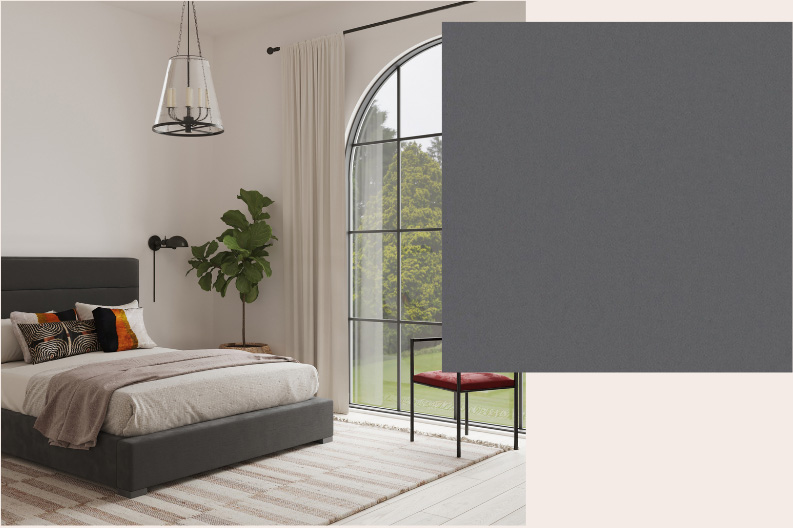April 08, 2022
A Guide to Choosing Your Furniture’s Upholstery
How to decide the best upholstery for your furniture!

As upholstered furniture experts, we know that when considering buying upholstered furniture, one of the first things you put thought into is what color would be best for your space. In fact, it’s normally the single biggest factor in fabric selection. Although color is important, there are other factors that are equally as important, such as durability, style you’d like to achieve, and the primary use-case of the furniture.
At Tandem Arbor, we offer seven different types of upholstery materials ranging from linen to velvet to leather. Each material type provides a different look and has different benefits based on how your furniture will be used and where it will be showcased. Keep scrolling for a guide to choosing your furniture’s upholstery based on Tandem Arbor’s upholstery line-up.
Box Weave Linen

Box Weave Linen is a loosely woven fabric that presents a variety of vivid colors. Though casual in feel, this fabric is crisp in tailoring. While it does not have the technical properties of a traditional performance fabric, the poly-blend of the weave gives it a high fabric abrasion resistance of 100,000 double rubs.
- Durability: High | 100,000 double rubs
- Performance: No
- Water Resistant: No
- Fabric Contents: 100% Polyester Blend
- Best for: High-traffic homes and a clean, crisp look that will be wrinkle resistant and not require maintenance.
Pebble Weave Linen

Pebble Weave Linen is a classic basket weave pattern that creates complex tones of color by weaving soft heathered filling yarns. It is a performance, eco-friendly linen-like fabric though casual in feel, this fabric is crisp in tailoring.
- Durability: High | 50,000 double rubs
- Performance: Yes
- Water Resistant: No
- Fabric Contents: 100% Polypropylene
- Best for: High-traffic homes with kids and/or pets and those that would like an eco-friendly product. A casual, yet crisp look with varying tones of color.
Basketweave

Basketweave is a textured woven performance fabric with subtle, varying colors woven in grove point pattern with luxuriously textured yarns. It marries old world design with new fiber technology to make an extremely versatile fabric, allowing for a multi-dimensional look.
- Durability: High | 30,000 double rubs
- Performance: Yes
- Water Resistant: No
- Fabric Contents: 96% Polypropylene, 4% Polyester
- Best for: Light to moderately-trafficked homes with kids, but not pets (claws won’t be able to stay away from this material). An old-world look tied with extreme versatility.
Crushed Velvet

Crushed velvet is a lustrous velvet weave with an enhanced texture in the pile to create a textured striation. This opulent fabric evokes the look of a silk velvet. It has a rich luster and supple hand creating a luxe look and a stylish option for adding a touch of glam.
- Durability: High | 100,000 double rubs
- Performance: Yes
- Water Resistant: Yes
- Fabric Contents: 100% Polyester
- Best for: High-traffic homes with kids and/or pets as the striations disguise pet hair and the velvet does not have a weave for any claws/nails to snag. A cuddly, yet luxurious option that will always look great, no matter your decor.
Plush Velvet

Plush Velvet is a buttery soft fabric with a subtle sheen and soft hand for an elegant look. This is considered a performance fabric because it is 100,000 double rubs and is inherently waterproof with an easy clean ability.
- Durability: High | 100,000 double rubs
- Performance: Yes
- Water Resistant: Yes
- Fabric Contents: 100% Polyester
- Best for: High-traffic homes with kids and/or pets as the velvet does not have a weave for claws to snag. A soft, yet luxurious option that will look great with any decor.
Vintage Leather

A pigmented semi-aniline Vintage Leather that has a distressed, oily pull-up featuring a natural grain and a light sheen, highlighting the handcrafted nature of leather with its aged appeal. Semi-aniline leather is made with a semi-aniline dye that contains just a small amount of pigment.
- Durability: Moderate | Semi-aniline leather is more durable than aniline leather while retaining a natural appearance. The increased durability is provided by the application of a light surface coating, which contains a small amount of pigment. It is resistant to scratching and stains, but it will still show.
- Performance: No
- Water Resistant: No
- Best for: Light to moderately-trafficked homes with kids, but not pets. A timeless, luxurious, handcrafted look that will last for years to come with the proper care and maintenance.
Distressed Leather

Distressed Leather is a European aniline leather with a matte finish and an aged appearance. Variances in color and markings, such as wrinkles, stretch marks, and healed scars, give each piece a unique beauty that only improves with age. Aniline leather is the most natural-looking leather type and is colored with subtle aniline dyes.
- Durability: Low to Moderate
- Performance: No
- Water Resistant: No
- Best for: Light to moderately-trafficked homes with kids, but not pets as this material scratches very easily. A timeless, lived-in, handcrafted look that will last for years to come with the proper care and maintenance.
Upholstery FAQ
What does “double rub” mean? What “double rubs” points to is the durability of a fabric and is a way to measure the abrasion resistance. Double rub is a test that wears down the fibers to understand how many “rubs” the fabric can withstand over time - one back and forth motion counts as one double rub. The test is meant to mimic the wear and tear of everyday use giving customers an idea of how long their fabric will last. In essence, it’s a security and code used in the fabric world - on linens and velvets - to guide homeowners and clients on what to select. As a rule of thumb, 30,000+ double rubs fits commercial grade standards.
What makes a fabric “performance”? The performance capabilities of fabric are completely dependent on the cloth’s composition. To achieve “performance”, the most common threads used are olefin, acrylic, nylon, and polyester. Performance traits include water resistance, stain resistance, mold and mildew resistance, light fastness, and durability. As leather materials do not contain any of the threads mentioned above, it can’t be considered performance nor is a fabric as it is a fully natural material.
What is semi-aniline leather? Semi-aniline leather is made much like its full aniline counterpart, with one main difference. That difference is that semi-aniline leather is made with semi-aniline dye that contains just a small amount of pigment. This means that the leather will have a more uniform coloring than a full aniline leather. Also, semi aniline leather still preserves the natural markings present in the leather while adding a thin protective layer which makes it more resistant to stains and wear than full aniline leather.
What is aniline leather? Aniline leather is the most natural-looking leather type and is colored with soluble aniline dyes. As it doesn't have a pigment based surface finish, aniline leather is a porous, smooth leather. The natural texture of the skin is clearly visible therefore aniline leather is usually classed as high-grade. The lack of a pigmented color layer on the surface means that aniline leather feels natural, soft and warm to touch.
What is polyester? Polyester is a synthetic fabric that’s usually derived from petroleum. This fabric is one of the world’s most popular textiles, specifically for upholstery, and it is used in thousands of different consumer and industrial applications. Here are some of the pros:
- Durability: Polyester upholstered furniture is very soft, comfortable, and extremely easy to clean. It also has an abrasion resistant quality which makes it durable. Polyester can resist more damage than natural materials. Although it may not stop all of the damage that your pets can cause, it will resist the impact of their claws and bites better than those of the natural fibers. Polyester is resistant to stretching and shrinking when washed.
- Breathability: Polyester fabric will not absorb smells and prevent sweat accumulation because of its more breathable quality.
- Fade Resistant: A polyester couch can withstand discoloration and can resist fading issues from sunshine or artificial light exposure.
- Stain Resistant: Polyester fabric will resist most stains better than natural materials since it dries very quickly in case of spills.
- Non-Allergenic: Polyester couch is naturally hypo-allergenic. There is a fewer risk of allergy development in polyester couch than that of using natural materials such as wool and cotton which create the most trigger.
What is polypropylene? Polypropylene fabric is a nonwoven textile, which means that it is made directly from a material without any need for spinning or weaving. Polypropylene is a term used to describe any textile product that is derived from the thermoplastic polymer polypropylene. This type of plastic is part of the polyolefin group and has extreme durability resulting in a high resistance to fatigue. A benefit of polypropylene is that it’s eco-friendly, recyclable, and doesn’t release as many toxins as other plastic materials.
Would you like to see how our upholstery options look in your home? Order free swatches!